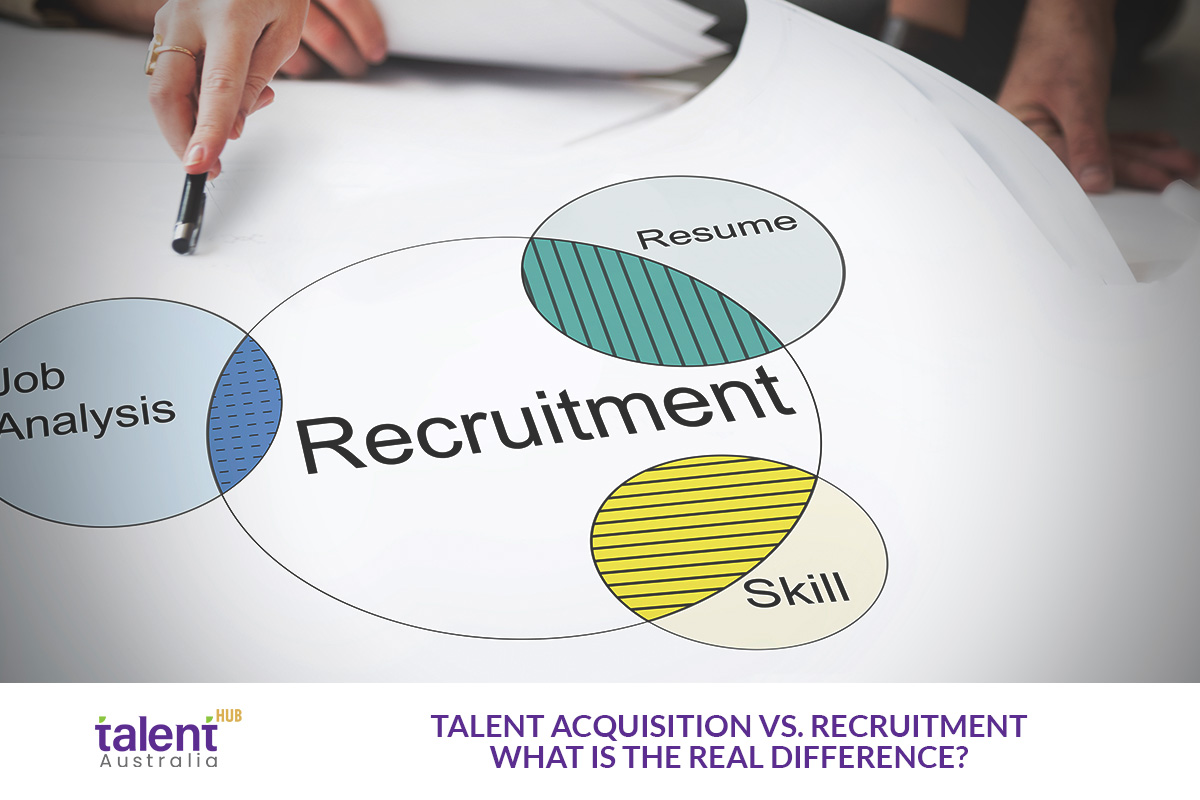
In today’s competitive job market in Australia, businesses across the country and globally face increasing pressure to secure the right talent. Whether you are scaling a start-up, managing rapid growth in a mid-sized organisation or leading a large enterprise, your recruitment and talent acquisition strategy makes all the difference in attracting and retaining top professionals especially in high-demand sectors like healthcare, NDIS and community services.
Two hiring terms are often used interchangeably: recruitment and talent acquisition. Yet, they represent very different approaches. Recruitment is short-term and reactive, while talent acquisition is long-term and strategic.
Understanding the difference between recruitment and talent acquisition and learning how to balance them helps businesses improve hiring outcomes, enhance retention and build a workforce that’s ready for the future.
What is Recruitment?
Recruitment refers to the tactical process of filling vacancies as they arise. It begins when a role opens and ends when the position is filled. The goal is to identify, attract and hire qualified candidates quickly and cost-effectively.
Typical recruitment activities include:
- Writing and posting job ads.
- Screening resumes and applications.
- Conducting interviews and assessments.
- Making offers and on boarding candidates.
For example, a retailer may recruit seasonal staff before peak trading periods, while a construction firm may urgently recruit project workers when demand spikes.
Recruitment is essential because businesses need to keep operations running. However, recruitment alone often keeps organisations in a reactive cycle, constantly responding to vacancies rather than anticipating future needs.
What is Talent Acquisition?
Talent acquisition is a broader, more strategic function that focuses on long-term workforce planning. Instead of filling vacancies reactively, organisations use talent acquisition to build pipelines of skilled professionals aligned with future goals.
Talent acquisition involves:
- Workforce forecasting: Anticipating skill needs based on business growth and market trends.
- Employer branding: Showcasing culture, values and opportunities to attract talent.
- Candidate relationship building: Engaging with passive candidates who may not be job-seeking now but could be valuable in the future.
- Succession planning: Preparing internal employees for leadership and critical roles.
For example, a tech company might establish graduate programs to secure future engineers, while a financial services firm might invest in employer branding campaigns to attract analysts in a competitive market.
Unlike recruitment, which focuses on the present, talent acquisition builds a foundation for future growth.
Recruitment vs. Talent Acquisition: Key Differences
Although both approaches aim to bring qualified people into an organisation, their scope, goals and outcomes differ.
Scope:
- Recruitment focuses on filling specific vacancies quickly.
- Talent acquisition considers the overall workforce strategy and long-term skill requirements.
Goals:
- Recruitment prioritises speed and efficiency.
- Talent acquisition prioritises quality, cultural fit and retention.
Metrics:
- Recruitment success is measured by time-to-hire, cost-per-hire and vacancy closure rates.
- Talent acquisition success is measured by employee performance, retention and pipeline health.
Together, they create a balanced hiring strategy that supports both short-term needs and long-term business goals.
How Technology is Changing Recruitment and Talent Acquisition
Technology continues to transform the way organisations approach hiring.
Recruitment technology improves efficiency. Applicant Tracking Systems (ATS), automated resume screening and scheduling tools reduce manual tasks and accelerate time-to-hire. These tools are especially valuable in high-volume hiring environments.
Talent acquisition technology strengthens strategy. Predictive analytics highlight upcoming skills shortages, Candidate Relationship Management (CRM) systems foster ongoing engagement with passive candidates and employer branding platforms help companies stand out in competitive industries.
Although both recruiters and talent acquisition specialists often use the same technology, they apply it differently. Recruiters focus on immediate vacancies, while talent acquisition professionals use insights to forecast and plan.
Why Businesses Need Both Recruitment and Talent Acquisition
Organisations cannot rely on one approach alone. Recruitment ensures roles are filled when urgent needs arise, while talent acquisition ensures a strong workforce pipeline for the future.
For instance:
- A professional services firm may recruit consultants urgently to meet client deadlines, while also engaging with universities to attract future talent.
- A manufacturing company may hire operators quickly for current production, while also investing in apprenticeship programs for long-term skills development.
By combining both strategies, businesses remain agile enough to respond to immediate challenges while preparing for future growth.
Building a Future-Ready Hiring Strategy
Today’s workforce is changing rapidly. Digital transformation, global competition and shifting employee expectations mean organisations must be ready to adapt. A future-ready hiring strategy integrates recruitment and talent acquisition into a connected approach.
To achieve this, businesses should:
- Forecast workforce needs and identify potential skills gaps.
- Strengthen employer branding to attract and retain top talent.
- Engage with active and passive candidates before roles open.
- Leverage HR technology to streamline processes and gather insights.
- Focus on employee retention through culture, career development and wellbeing initiatives.
This balanced approach ensures organisations can meet today’s staffing needs while building long-term resilience.
Final Thoughts
Recruitment and talent acquisition are not the same. Recruitment addresses immediate hiring needs, while talent acquisition builds a sustainable pipeline for future growth. Organisations that rely solely on recruitment risk staying reactive, while those that invest only in talent acquisition may leave critical roles unfilled.
The most successful businesses combine both approaches. By integrating recruitment efficiency with the strategic foresight of talent acquisition organisations build stronger teams, reduce turnover and prepare for future challenges. In short: recruitment fills today’s roles, but talent acquisition secures tomorrow’s success.
